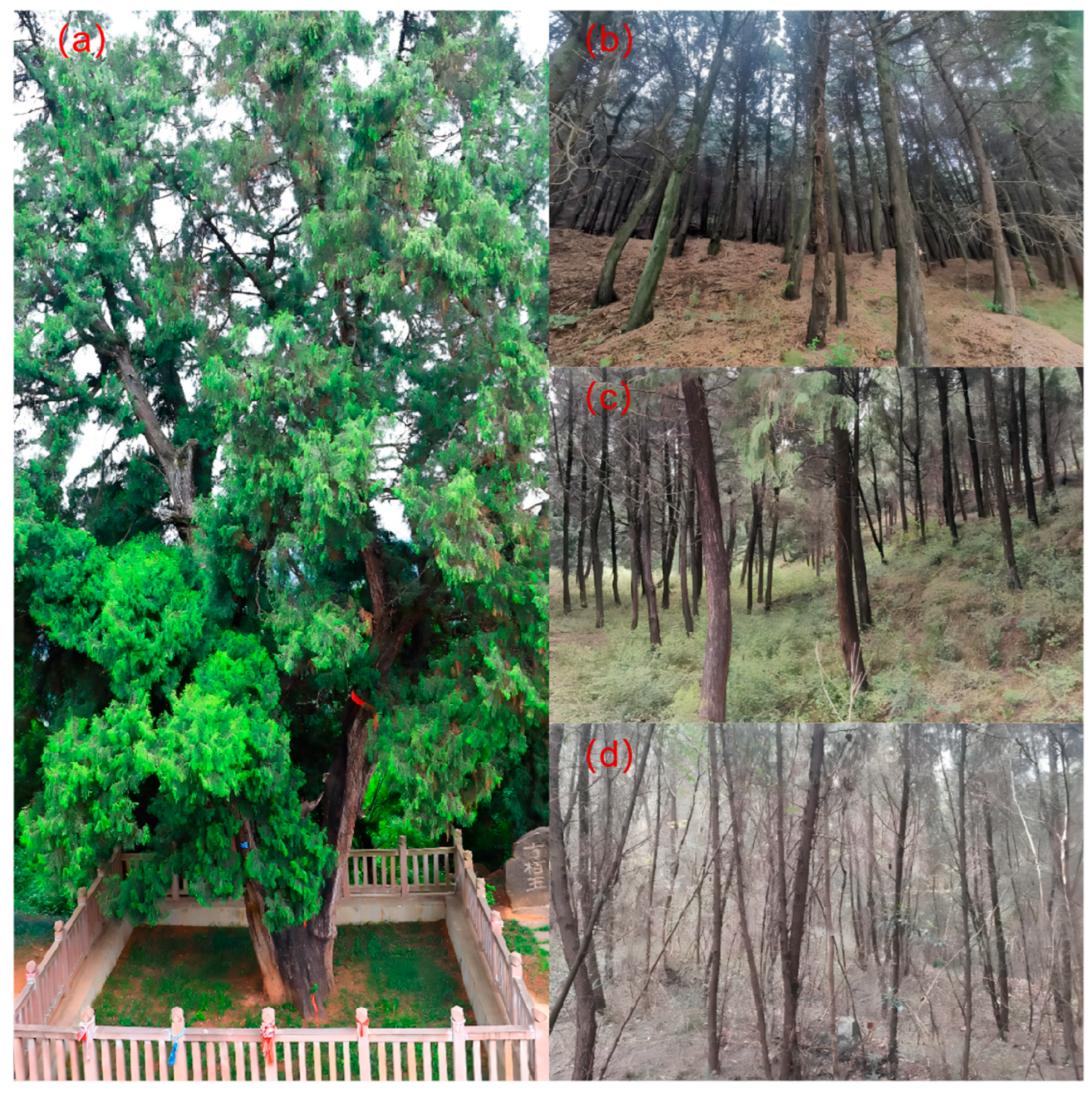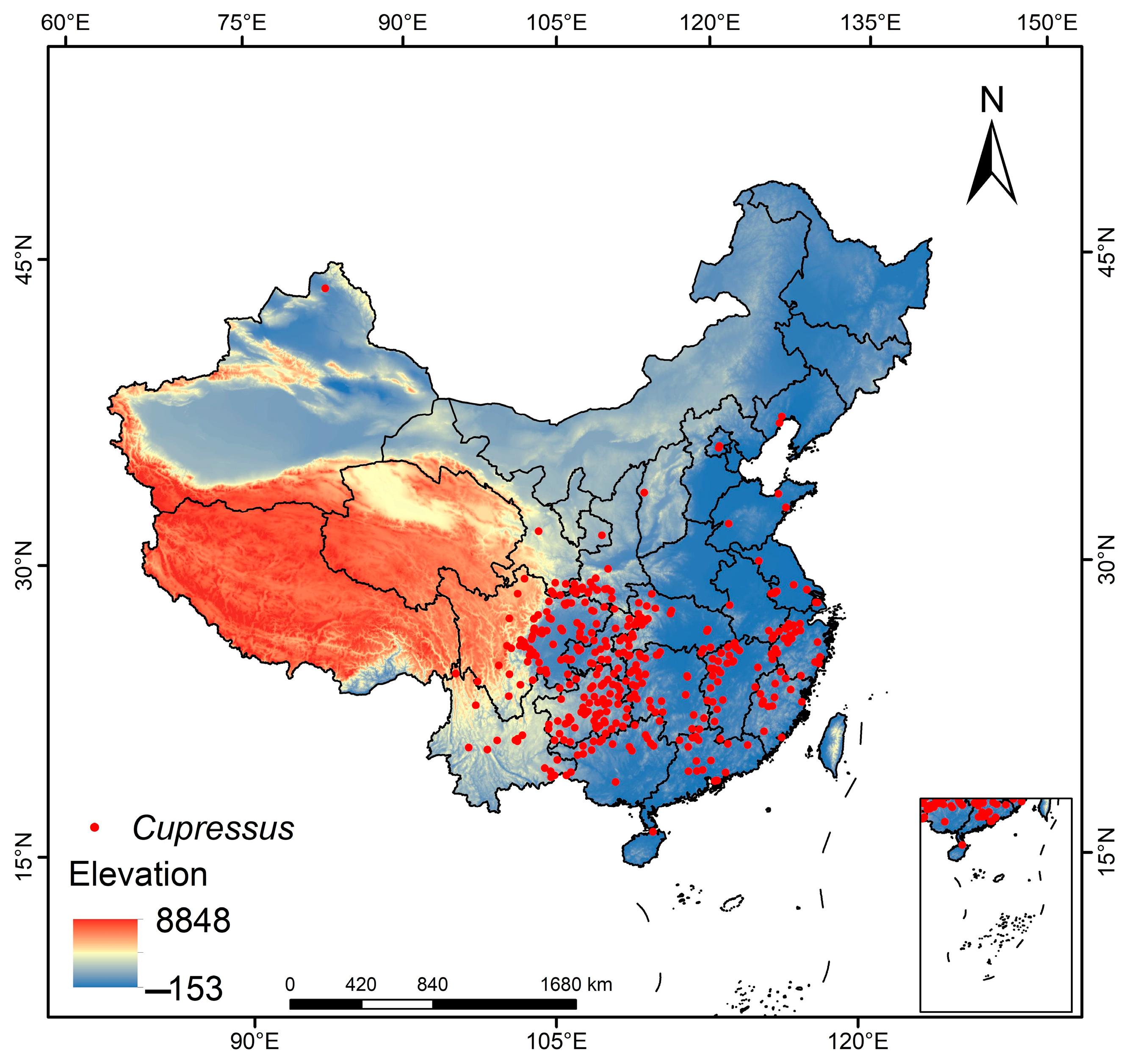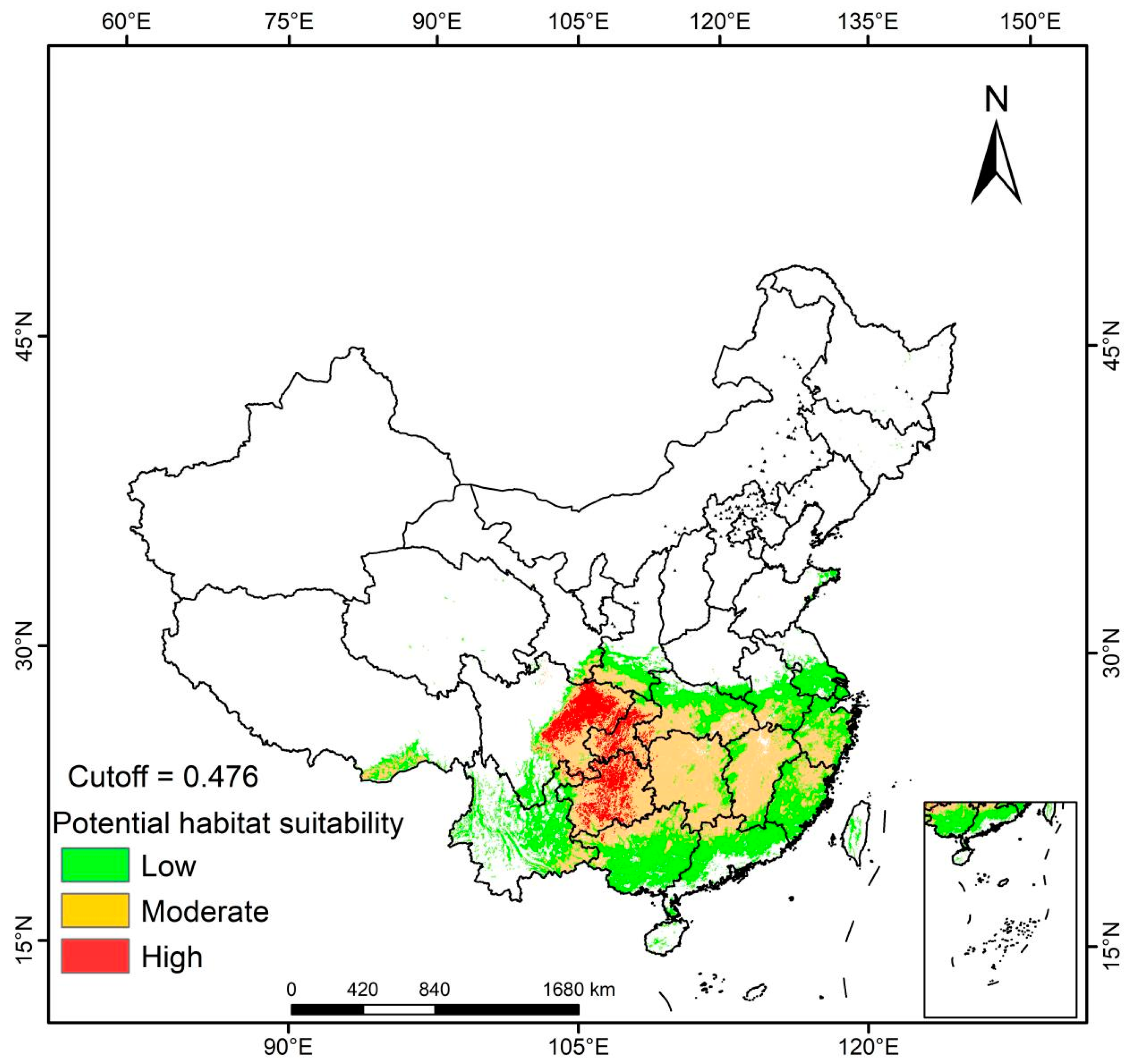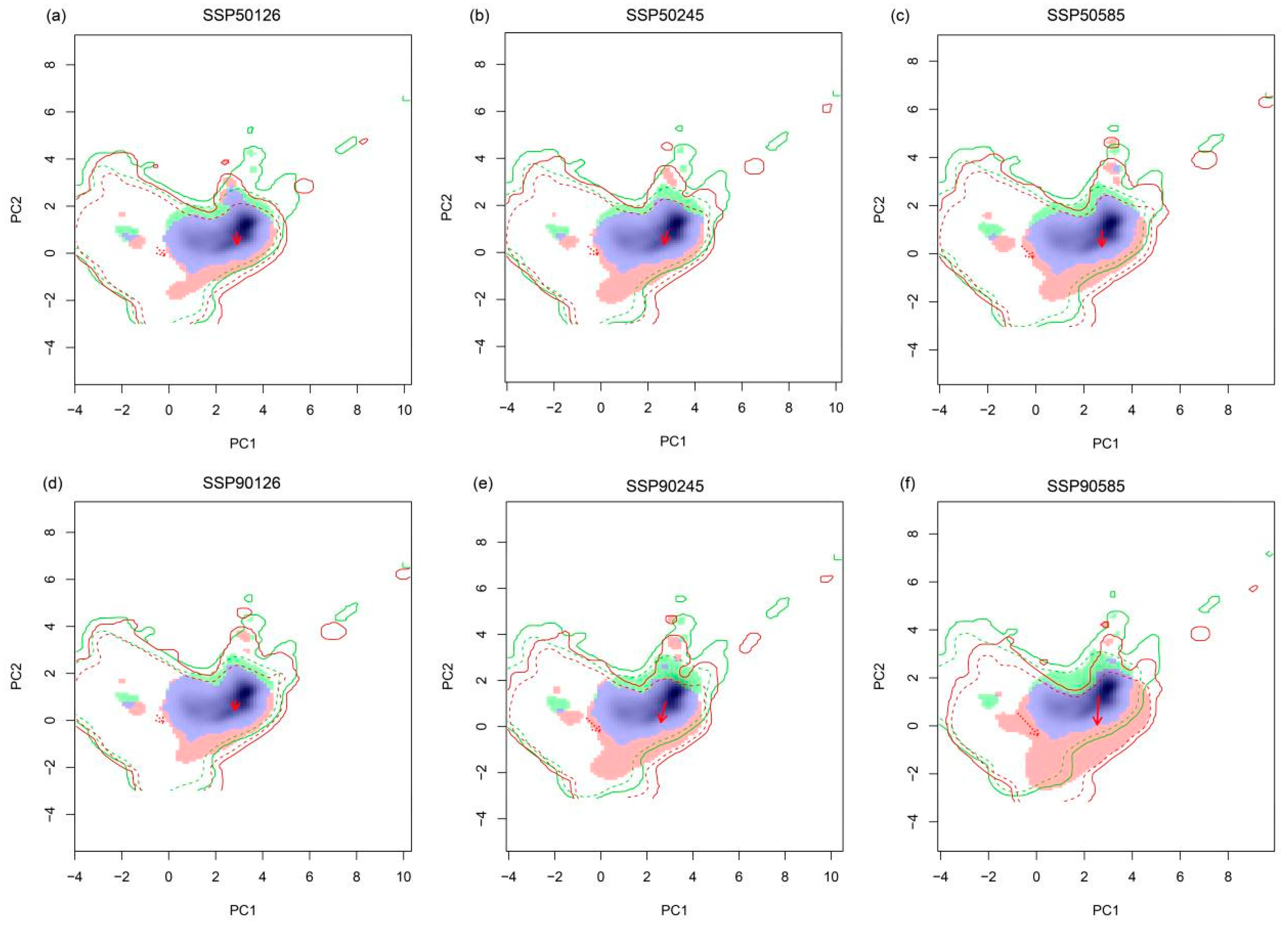Spatial Distribution Patterns of the Key Afforestation Species Cupressus funebris: Insights from an Ensemble Model under Climate Change Scenarios
Abstract
:1. Introduction
2. Materials and Methods
2.1. Study Area
2.2. Collection of Sample and Species Distribution Records
2.3. Selection and Processing of Environmental Variables for Modeling
2.4. Construction of the Ensemble Model and Evaluation
2.5. The Change in the Geographical Range of the Niche
2.6. Analysis of Stand Characteristics
3. Results and Analysis
3.1. Model Accuracy Evaluation
3.2. Current Potential Geographical Distributions of C. funebris
3.3. Future Potential Geographical Distributions of C. funebris
3.4. Future Ecological Change in the Geographical Range of the Niche Analysis
3.5. Forest Stand Characteristics Analysis under Different Habitat Suitability Scenarios
4. Discussion
5. Conclusions
Supplementary Materials
Author Contributions
Funding
Data Availability Statement
Conflicts of Interest
Glossary
| ANN | Artificial neural network |
| AR6 | Sixth assessment report |
| CTA | Classification tree analysis |
| FDA | Flexible discriminant analysis |
| GAM | Generalized additive models |
| GBM | Gradient boosting model |
| GLM | Generalized linear model |
| IPCC | Intergovernmental panel on climate change |
| MARS | Multivariate adaptive regression spline |
| MAXent | Maximum entropy model |
| MAXnet | maximum picking neural net |
| PCA | Principal component analysis |
| RF | Random forest |
| ROC | Receiver operating characteristic |
| SDMs | Species distribution models |
| SRE | Species range expansion |
| SSP | Shared socioeconomic pathways |
| TSS | True skill statistic |
References
- Helbling, M.; Meierrieks, D. Global warming and urbanization. J. Popul. Econ. 2023, 36, 1187–1223. [Google Scholar] [CrossRef]
- Zheng, X.; Zhang, D.; Su, J.; Chen, H. Prediction of Carbon Emission Based on Energy Consumption Structure by Statistical Forecasting. In Proceedings of the International Conference on Statistics, Applied Mathematics, and Computing Science (CSAMCS 2021), Nanjing, China, 26–28 November 2021; SPIE: Bellingham, WA, USA, 2022; Volume 12163, pp. 298–304. [Google Scholar]
- Jin, S.; Chi, Y.; Li, X.; Shu, P.; Zhu, M.; Yuan, Z.; Liu, Y.; Chen, W.; Han, Y. Predicting the Response of Three Common Subtropical Tree Species in China to Climate Change. Front. For. Glob. Chang. 2023, 6, 1299120. [Google Scholar] [CrossRef]
- Carrell, J.D.; Phinney, A.I.; Mueller, K.; Bean, B. Multiscale Ecological Niche Modeling Exhibits Varying Climate Change Impacts on Habitat Suitability of Madrean Pine-Oak Trees. Front. Ecol. Evol. 2023, 11, 1086062. [Google Scholar] [CrossRef]
- Gao, M.; Zhao, G.; Zhang, S.; Wang, Z.; Wen, X.; Liu, L.; Zhang, C.; Tie, N.; Sa, R. Priority Conservation Area of Larix gmelinii under Climate Change: Application of an Ensemble Modeling. Front. Plant Sci. 2023, 14, 1177307. [Google Scholar] [CrossRef]
- Miao, G.; Zhao, Y.; Wang, Y.; Yu, C.; Xiong, F.; Sun, Y.; Cao, Y. Suitable Habitat Prediction and Analysis of Dendrolimus houi and Its Host Cupressus funebris in the Chinese Region. Forests 2024, 15, 162. [Google Scholar] [CrossRef]
- Gao, M.; Tie, N.; Zhang, C.; Li, F.; Wu, Y.; Luo, Q.; Wang, Z.; Liu, L.; Sa, R. Modeling the Potential Distribution Area of Populus davidiana in China Based on the Biomod2. J. Nanjing For. Univ. 2024, 48, 247. [Google Scholar]
- Patasaraiya, M.K.; Devi, R.M.; Sinha, B.; Bisaria, J. Predicting Impacts of Climate Change on Teak and Sal Forests in Central India Using Maximum Entropy Modeling: An Approach for Future Conservation and Silvicultural Strategies. For. Sci. 2023, 69, 463–472. [Google Scholar] [CrossRef]
- Yang, J.; Jiang, X.; Ma, Y.; Liu, M.; Shama, Z.; Li, J.; Huang, Y. Potential Global Distribution of Setaria italica, an Important Species for Dryland Agriculture in the Context of Climate Change. PLoS ONE 2024, 19, e0301751. [Google Scholar] [CrossRef]
- Yang, J.; Huang, Y.; Jiang, X.; Chen, H.; Liu, M.; Wang, R. Potential Geographical Distribution of the Edangred Plant Isoetes under Human Activities Using MaxEnt and GARP. Glob. Ecol. Conserv. 2022, 38, e02186. [Google Scholar] [CrossRef]
- Wang, T.; Zhang, T.; An, W.; Wang, Z.; Li, C. Predicting the Potential Geographic Distribution of Invasive Freshwater Apple Snail Pomacea canaliculate (Lamarck, 1819) under Climate Change Based on Biomod2. Agronomy 2024, 14, 650. [Google Scholar] [CrossRef]
- Wang, H.; Zhi, F.; Zhang, G. Predicting Impacts of Climate Change on Suitable Distribution of Critically Endangered Tree Species Yulania zenii in China. Forests 2024, 15, 883. [Google Scholar] [CrossRef]
- Gao, C.; Guo, S.; Ma, C.; Yang, J.; Kang, X.; Li, R. Impact of Climate Change on the Potential Geographical Distribution Patterns of Luculia pinceana Hook. f. since the Last Glacial Maximum. Forests 2024, 15, 253. [Google Scholar] [CrossRef]
- Zhang, H.T.; Wang, W.T. Prediction of the Potential Distribution of the Endangered Species Meconopsis punicea Maxim under Future Climate Change Based on Four Species Distribution Models. Plants 2023, 12, 1376. [Google Scholar] [CrossRef]
- Qiao, H.; Feng, X.; Escobar, L.E.; Peterson, A.T.; Soberón, J.; Zhu, G.; Papeş, M. An Evaluation of Transferability of Ecological Niche Models. Ecography 2019, 42, 521–534. [Google Scholar] [CrossRef]
- Araujo, M.; New, M. Ensemble forecasting of species distributions. Trends Ecol. Evol. 2007, 22, 42–47. [Google Scholar] [CrossRef]
- Chen, Y.; Jiang, Z.; Fan, P.; Ericson, P.G.P.; Song, G.; Luo, X.; Lei, F.; Qu, Y. The Combination of Genomic Offset and Niche Modeling Provides Insights into Climate Change-Driven Vulnerability. Nat. Commun. 2022, 13, 4821. [Google Scholar] [CrossRef]
- Thuiller, W.; Lafourcade, B.; Engler, R.; Araújo, M.B. BIOMOD—A Platform for Ensemble Forecasting of Species Distributions. Ecography 2009, 32, 369–373. [Google Scholar] [CrossRef]
- Hao, T.; Elith, J.; Lahoz-Monfort, J.J.; Guillera-Arroita, G. Testing Whether Ensemble Modeling Is Advantageous for Maximising Predictive Performance of Species Distribution Models. Ecography 2020, 43, 549–558. [Google Scholar] [CrossRef]
- Shabani, F. Assessing Accuracy Methods of Species Distribution Models: AUC, Specificity, Sensitivity and the True Skill Statistic. Glob. J. Hum.-Soc. Sci. 2018, 18, 7–18. [Google Scholar]
- Ángel-Vallejo, M.C.; Aguirre-Acosta, N.; Rodríguez-Rey, G.T.; García-Marín, E.J.; Álvarez-Mejía, L.M.; Feuillet-Hurtado, C. Distribution Models in Invasive Plants with Climatic Niche Expansion: A Case Study of Ulex europaeus L. in Colombian Andes. Biol. Invasions 2024, 26, 1919–1930. [Google Scholar] [CrossRef]
- Ruizhi, L.I.; Xijun, H.U.; Qizhen, L.I.; Luyun, L.I.U.; Yuanrong, H.E.; Cunyou, C. Gap Analysis of Firmiana danxiaensis, a Rare Tree Species Endemic to Southern China. Ecol. Indic. 2024, 158, 111606. [Google Scholar]
- Yang, J.; Wu, Q.; Dakhil, M.A.; Halmy, M.W.A.; Bedair, H.; Fouad, M.S. Towards Forest Conservation Planning: How Temperature Fluctuations Determine the Potential Distribution and Extinction Risk of Cupressus funebris Conifer Trees in China. Forests 2023, 14, 2234. [Google Scholar] [CrossRef]
- Farasat, N.; Zangeneh, M.; Salimi-Sabour, E.; Eidizade, A.; Golmohammadi, R. Antibacterial Activities and Chemical Composition of Essential Oils of Cupressus sempervirence L. and C. funebris Endl. in Khuzestan, Iran. Microbiol. Metab. Biotechnol. 2023, 6, 19–26. [Google Scholar]
- Wang, R.; Guo, Y.; Lin, H.; Liu, Z.; Zhang, R.; Zhou, Z. Research Progress and Prospect of Cupressus funebris. Hubei For. Sci. Technol. 2021, 50, 60–63. [Google Scholar]
- Yan, M. Cypress Cultivation Techniques and Applications. Mod. Agric. Sci. Technol. 2013, 18, 54. [Google Scholar]
- Yang, T.; Qiu, Y.; Shen, H.; Zheng, C.; Zhang, Z.; Wang, W.W.; Jin, G.; Zhou, Z. Early Evaluation of Carbon Content of Cypress Clones and Families and Selection of Superior Strains. Sci. Silvae Sin. 2023, 59, 85–94. [Google Scholar]
- Chen, B.; Wu, Y.; Zhong, X.; Xu, Y.; Chen, H.; Tang, L.; Bai, Y.; Hao, J. Effects of Stand Density on Understory Plant Diversity and Biomass in a Cupressus funebris Plantation in Yunding Mountain. J. Sichuan Agric. Univ. 2023, 41, 665–672. [Google Scholar] [CrossRef]
- Zhao, H. Response of Potential Geographic Distribution of Eight Critically Endangered Plant Species in China to Climate Change and Their Gap Analysis. Master’s Thesis, Northwest Normal University, Lanzhou, China, 2021. Available online: https://cdmd.cnki.com.cn/Article/CDMD-10736-1021661814.htm (accessed on 28 June 2024).
- Fick, S.E.; Hijmans, R.J. WorldClim 2: New 1-km Spatial Resolution Climate Surfaces for Global Land Areas. Int. J. Climatol. 2017, 37, 4302–4315. [Google Scholar] [CrossRef]
- Sun, C.; Zuo, J.; Shi, X.; Liu, X.; Liu, H. Diverse Inter-Annual Variations of Winter Siberian High and Link with Eurasian Snow in Observation and BCC-CSM2-MR Coupled Model Simulation. Front. Earth Sci. 2021, 9, 761311. [Google Scholar] [CrossRef]
- Milovac, J.; Ingwersen, J.; Warrach-Sagi, K. Global Top Soil Texture Data Compatible with the WRF Model Based on the Harmonized World Soil Database (HWSD) at 30 Arc-Second Horizontal Resolution Version 1.21; World Data Center for Climate (WDCC) at DKRZ: Hamburg, Germany, 2018. [Google Scholar]
- Elith, J.H.; Graham, C.P.H.; Anderson, R.P.; Dudík, M.; Ferrier, S.; Guisan, A.; Hijmans, R.J.; Huettmann, F.; Leathwick, J.R.; Lehmann, A.; et al. Novel Methods Improve Prediction of Species’ Distributions from Occurrence Data. Ecography 2006, 29, 129–151. [Google Scholar] [CrossRef]
- Allouche, O.; Tsoar, A.; Kadmon, R. Assessing the Accuracy of Species Distribution Models: Prevalence, Kappa and the True Skill Statistic (TSS). J. Appl. Ecol. 2006, 43, 1223–1232. [Google Scholar] [CrossRef]
- Di Cola, V.; Broennimann, O.; Petitpierre, B.; Breiner, F.T.; D’Amen, M.; Randin, C.; Engler, R.; Pottier, J.; Pio, D.; Dubuis, A.; et al. Ecospat: An R Package to Support Spatial Analyses and Modeling of Species Niches and Distributions. Ecography 2017, 40, 774–787. [Google Scholar] [CrossRef]
- Ali, H.; Mohammadi, J.; Shataee Jouibary, S. Allometric Models and Biomass Conversion and Expansion Factors to Predict Total Tree-Level Aboveground Biomass for Three Conifers Species in Iran. For. Sci. 2023, 69, 355–370. [Google Scholar] [CrossRef]
- Shingleton, A.W.; Frankino, W.A. The (Ongoing) Problem of Relative Growth. Curr. Opin. Insect Sci. 2018, 25, 9–19. [Google Scholar] [CrossRef] [PubMed]
- Bellard, C.; Bertelsmeier, C.; Leadley, P.; Thuiller, W.; Courchamp, F. Impacts of Climate Change on the Future of Biodiversity. Ecol. Lett. 2012, 15, 365–377. [Google Scholar] [CrossRef] [PubMed]
- Rushing, C.S.; Rubenstein, M.; Lyons, J.E.; Runge, M.C. Using Value of Information to Prioritize Research Needs for Migratory Bird Management under Climate Change: A Case Study Using Federal Land Acquisition in the United States. Biol. Rev. 2020, 95, 1109–1130. [Google Scholar] [CrossRef]
- Garcia, K.; Lasco, R.; Ines, A.; Lyon, B.; Pulhin, F. Predicting Geographic Distribution and Habitat Suitability Due to Climate Change of Selected Threatened Forest Tree Species in the Philippines. Appl. Geogr. 2013, 44, 12–22. [Google Scholar] [CrossRef]
- Karypidou, M.C.; Almpanidou, V.; Tompkins, A.M.; Mazaris, A.D.; Gewehr, S.; Mourelatos, S.; Katragkou, E. Projected Shifts in the Distribution of Malaria Vectors Due to Climate Change. Clim. Change 2020, 163, 2117–2133. [Google Scholar] [CrossRef]
- Carosi, A.; Ghetti, L.; Padula, R.; Lorenzoni, M. Population Status and Ecology of the Salmo trutta Complex in an Italian River Basin under Multiple Anthropogenic Pressures. Ecol. Evol. 2020, 10, 7320–7333. [Google Scholar] [CrossRef] [PubMed]
- Gerber, L.R.; Hyrenbach, K.D.; Zacharias, M.A. Do the Largest Protected Areas Conserve Whales or Whalers? Science 2005, 307, 525–526. [Google Scholar] [CrossRef]
- Avasthi, A. California Tries to Connect Its Scattered Marine Reserves. Science 2005, 308, 487–488. [Google Scholar] [CrossRef]
- Zhang, P.; Liang, Y.; Liu, B.; Ma, T.; Wu, M. Remote sensing estimation of forest aboveground biomass in Tibetan Plateau based on random forest model. Chin. J. Ecol. 2023, 42, 415–424. [Google Scholar] [CrossRef]
- Chen, Q. Characteristics of Wetland Plant Community and Its Relationship with Environmental Factors in Nianchu River Basin. Master’s Thesis, Tibet University, Lhasa, China, 2022. [Google Scholar]
- Thomas, C.D.; Cameron, A.; Green, R.E.; Bakkenes, M.; Beaumont, L.J.; Collingham, Y.C.; Erasmus, B.F.; De Siqueira, M.F.; Grainger, A.; Hannah, L. Extinction Risk from Climate Change. Nature 2004, 427, 145–148. [Google Scholar] [CrossRef] [PubMed]
- Zhang, Z. Initial Effects of Two Tending Measures on Carbon Storage and Soil Active Organic Carbon Pool of Cypress Plantation. Master’s Thesis, Sichuan Agricultural University, Chengdu, China, 2023. [Google Scholar]
- Liu, Y.; Wang, Y.; Guo, H.; Wu, D.; Wu, S.; Xin, X.; Pei, S. Changes in Potentially Suitable Areas for Fruit Utilization of Acer truncatum in China under Climate Change. Forests 2024, 15, 713. [Google Scholar] [CrossRef]
- Flower, A.; Murdock, T.Q.; Taylor, S.W.; Zwiers, F.W. Using an Ensemble of Downscaled Climate Model Projections to Assess Impacts of Climate Change on the Potential Distribution of Spruce and Douglas-Fir Forests in British Columbia. Environ. Sci. Policy 2013, 26, 63–74. [Google Scholar] [CrossRef]
- Leng, W.; He, H.S.; Bu, R.; Dai, L.; Hu, Y.; Wang, X. Predicting the Distributions of Suitable Habitat for Three Larch Species under Climate Warming in Northeastern China. For. Ecol. Manag. 2008, 254, 420–428. [Google Scholar] [CrossRef]
- Thuiller, W.; Lavorel, S.; Araújo, M.B.; Sykes, M.T.; Prentice, I.C. Climate Change Threats to Plant Diversity in Europe. Proc. Natl. Acad. Sci. USA 2005, 102, 8245–8250. [Google Scholar] [CrossRef]
- Masson-Delmotte, V.; Zhai, P.; Pirani, S.; Connors, C.; Péan, S.; Berger, N.; Caud, Y.; Chen, L.; Goldfarb, M.; Scheel Monteiro, P.M. Summary for Policymakers. In Climate Change 2021—The Physical Science Basis: Working Group I Contribution to the Sixth Assessment Report of the Intergovernmental Panel on Climate Change; Intergovernmental Panel on Climate Change (IPCC), Ed.; Cambridge University Press: Cambridge, UK, 2023; pp. 3–32. ISBN 978-1-00-915788-9. [Google Scholar]
- Chen, I.C.; Hill, J.K.; Ohlemüller, R.; Roy, D.B.; Thomas, C.D. Rapid Range Shifts of Species Associated with High Levels of Climate Warming. Science 2011, 333, 1024–1026. [Google Scholar] [CrossRef]
- Harsch, M.A.; Hulme, P.E.; McGlone, M.S.; Duncan, R.P. Are Treelines Advancing? A Global Meta-analysis of Treeline Response to Climate Warming. Ecol. Lett. 2009, 12, 1040–1049. [Google Scholar] [CrossRef]
- Sala, O.E.; Maestre, F.T. Grass–Woodland Transitions: Determinants and Consequences for Ecosystem Functioning and Provisioning of Services. J. Ecol. 2014, 102, 1357–1362. [Google Scholar] [CrossRef]
- Cheng, R.; Xiao, W.; Li, J. Research on Cypress Forests in the Three Gorges Reservoir Area. In Proceedings of the 11th Symposium of the 2004 China Association for Science and Technology Annual Conference, Qionghai, China, 20–23 November 2004; The China Technical Association of Paper Industry: Beijing, China, 2004; p. 3. [Google Scholar]
- Zhang, R.; Li, S.; Ma, G.; Su, J. Driving Factors for the Biomass of Individual Cupressus funebris in Southwest China. J. Northwest For. Univ. 2021, 36, 175–181. [Google Scholar] [CrossRef]
- Måsviken, J.; Dalerum, F.; Cousins, S.A.O. Contrasting Altitudinal Variation of Alpine Plant Communities along the Swedish Mountains. Ecol. Evol. 2020, 10, 4838–4853. [Google Scholar] [CrossRef] [PubMed]
- Stomp, M.; Huisman, J.; Mittelbach, G.G.; Litchman, E.; Klausmeier, C.A. Large-Scale Biodiversity Patterns in Freshwater Phytoplankton. Ecology 2011, 92, 2096–2107. [Google Scholar] [CrossRef] [PubMed]
- Xu, M.; Ma, L.; Jia, Y.; Liu, M. Integrating the Effects of Latitude and Altitude on the Spatial Differentiation of Plant Community Diversity in a Mountainous Ecosystem in China. PLoS ONE 2017, 12, e0174231. [Google Scholar] [CrossRef] [PubMed]
- Scheffers, B.R.; Phillips, B.L.; Laurance, W.F.; Sodhi, N.S.; Diesmos, A.; Williams, S.E. Increasing Arboreality with Altitude: A Novel Biogeographic Dimension. Proc. R. Soc. B Biol. Sci. 2013, 280, 20131581. [Google Scholar] [CrossRef] [PubMed]
- Jackson, J.; Pimsler, M.L.; Oyen, K.; Koch-Uhuad, J.B.; Herndon, J.D.; Strange, J.; Dillon, M.; Lozier, J.D. Distance, Elevation and Environment as Drivers of Diversity and Divergence in Bumble Bees across Latitude and Altitude. Mol. Ecol. 2018, 27, 2926–2942. [Google Scholar] [CrossRef] [PubMed]
- Huang, Y.; Zeng, Y.; Jiang, P.; Chen, H.; Yang, J. Prediction of Potential Geographic Distribution of Endangered Relict Tree Species Dipteronia sinensis in China Based on MaxEnt and GIS. Pol. J. Environ. Stud. 2022, 31, 3597–3609. [Google Scholar] [CrossRef]






| Climate Scenarios | Highly Suitable Area | Moderately Suitable Area | Lowly Suitable Area | Total Suitable Area | ||||
|---|---|---|---|---|---|---|---|---|
| Area (104 km2) | Increase Rate (%) | Area (104 km2) | Increase Rate (%) | Area (104 km2) | Increase Rate (%) | Area (104 km2) | Increase Rate (%) | |
| Current | 15.651 | - | 86.601 | - | 78.509 | - | 180.760 | - |
| 2050s-SSP126 | 34.807 | 122.39% | 90.616 | 4.64% | 75.797 | −3.45% | 201.220 | 11.32% |
| 2050s-SSP245 | 29.514 | 88.58% | 110.542 | 27.65% | 98.361 | 25.29% | 238.417 | 31.90% |
| 2050s-SSP585 | 34.920 | 123.12% | 104.740 | 20.95% | 95.595 | 21.76% | 235.255 | 30.15% |
| 2090s-SSP126 | 32.040 | 104.72% | 99.250 | 14.61% | 85.771 | 9.25% | 217.061 | 20.08% |
| 2090s-SSP245 | 23.267 | 48.66% | 115.556 | 33.43% | 113.106 | 44.07% | 251.929 | 39.37% |
| 2090s-SSP585 | 28.986 | 85.20% | 110.679 | 27.80% | 117.130 | 49.19% | 256.795 | 42.06% |
Disclaimer/Publisher’s Note: The statements, opinions and data contained in all publications are solely those of the individual author(s) and contributor(s) and not of MDPI and/or the editor(s). MDPI and/or the editor(s) disclaim responsibility for any injury to people or property resulting from any ideas, methods, instructions or products referred to in the content. |
© 2024 by the authors. Licensee MDPI, Basel, Switzerland. This article is an open access article distributed under the terms and conditions of the Creative Commons Attribution (CC BY) license (https://creativecommons.org/licenses/by/4.0/).
Share and Cite
Yang, J.; Huang, Y.; Su, M.; Liu, M.; Yang, J.; Wu, Q. Spatial Distribution Patterns of the Key Afforestation Species Cupressus funebris: Insights from an Ensemble Model under Climate Change Scenarios. Forests 2024, 15, 1280. https://doi.org/10.3390/f15081280
Yang J, Huang Y, Su M, Liu M, Yang J, Wu Q. Spatial Distribution Patterns of the Key Afforestation Species Cupressus funebris: Insights from an Ensemble Model under Climate Change Scenarios. Forests. 2024; 15(8):1280. https://doi.org/10.3390/f15081280
Chicago/Turabian StyleYang, Jingtian, Yi Huang, Miaomiao Su, Mei Liu, Jingxuan Yang, and Qinggui Wu. 2024. "Spatial Distribution Patterns of the Key Afforestation Species Cupressus funebris: Insights from an Ensemble Model under Climate Change Scenarios" Forests 15, no. 8: 1280. https://doi.org/10.3390/f15081280





